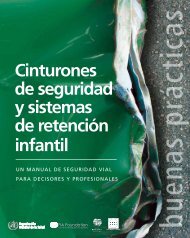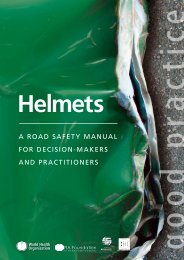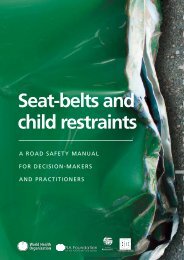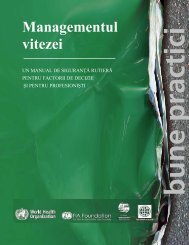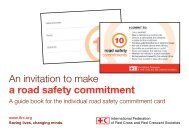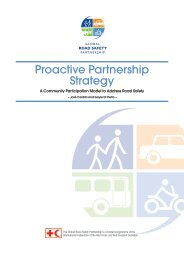How to design and implement a drinking and driving programme pdf ...
How to design and implement a drinking and driving programme pdf ...
How to design and implement a drinking and driving programme pdf ...
Create successful ePaper yourself
Turn your PDF publications into a flip-book with our unique Google optimized e-Paper software.
Additional relevant <strong>drinking</strong> <strong>and</strong> <strong>driving</strong> legislation<br />
Legislation specifying BAC limits <strong>and</strong> how these are <strong>to</strong> be enforced are a corners<strong>to</strong>ne<br />
of any national or regional <strong>programme</strong> <strong>to</strong> reduce <strong>drinking</strong> <strong>and</strong> <strong>driving</strong>. Additional<br />
types of legislation targeting, for example, known high risk groups such as young<br />
drivers, regulating the sale of beverage alcohol (e.g. <strong>to</strong> specific hours), taxation on<br />
beverage alcohol <strong>to</strong> decrease its accessibility, <strong>and</strong> licensing premises selling beverage<br />
alcohol have been enacted in many countries in an effort <strong>to</strong> curb the occurrence<br />
of <strong>drinking</strong> <strong>and</strong> <strong>driving</strong> with positive results. A few of these types of legislation are<br />
described below.<br />
Minimum legal <strong>drinking</strong> age<br />
Drinking <strong>and</strong> Driving: a road safety manual<br />
In some countries minimum legal <strong>drinking</strong> age (MLDA) laws specify an age below<br />
which people cannot purchase or publicly consume alcohol. In the US, an individual<br />
must be at least 21 years of age <strong>to</strong> purchase alcoholic beverages; in Denmark<br />
the MLDA is set six years lower at 15 years. In several other European countries the<br />
MLDA varies for beer, wine <strong>and</strong> spirits. There is strong evidence <strong>to</strong> suggest that<br />
MLDA laws are effective in preventing crashes involving <strong>drinking</strong> <strong>and</strong> <strong>driving</strong> (7).<br />
3 | <strong>How</strong> <strong>to</strong> <strong>design</strong> <strong>and</strong> <strong>implement</strong> a <strong>drinking</strong> <strong>and</strong> <strong>driving</strong> <strong>programme</strong><br />
Statistics collected by the United States General Accounting Office (1987)<br />
show that states which adopted the minimum legal <strong>drinking</strong> age of 21 in the<br />
1980s experienced a 10–15% decline in drink-<strong>driving</strong> related fatalities among<br />
drivers compared with states that did not adopt such laws. Further, the National<br />
Highway Traffic Safety Administration (NHTSA) predicts that on average, 1000<br />
fatalities per annum caused by <strong>drinking</strong> <strong>and</strong> <strong>driving</strong> are avoided through the<br />
introduction of a MLDA of 21 within US states.<br />
Alcohol sales points<br />
Some regions have <strong>implement</strong>ed laws limiting the hours during which alcohol can be<br />
sold, or the density of outlets selling beverage alcohol. There is evidence that, in some<br />
circumstances, a relationship exists between alcohol-related problems <strong>and</strong> both outlet<br />
density <strong>and</strong> hours during which alcohol can be sold, with longer hours <strong>and</strong> more<br />
outlets leading <strong>to</strong> increased problems <strong>and</strong> shorter hours <strong>and</strong> a reduction in outlets<br />
resulting in a reduction in such problems, including road deaths (10). These measures<br />
may be most effective when they impact upon large geographic areas so as <strong>to</strong> minimise<br />
opportunities for circumvention.<br />
77



